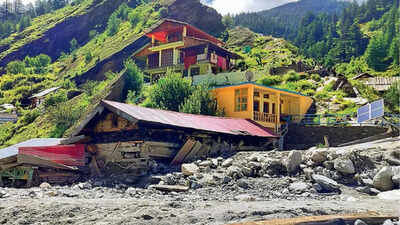ARTICLE AD BOX

DEHRADUN: Almost a week after the Aug 5 flash flood in Dharali, officials on Monday said for the first time that 43 people were still missing, and issued warning saying "heavy to very heavy" rainfall forecast for Uttarkashi and surrounding districts until Aug 15 could cause fresh landslides and flooding, further delaying search and relief operations.

Garhwal commissioner Vinay Shankar Pandey said finding those trapped under debris was the administration's highest priority. A joint task force from National Disaster Response Force, State Disaster Response Force, Indo-Tibetan Border Police (ITBP), and a team of geologists, has been working in the disaster zone, where unstable slopes and broken roads complicate even short journeys. "Among the missing are nine Army personnel, eight Dharali locals, five residents from nearby villages, and others from Tehri, Bihar, Uttar Pradesh, and Nepal," Pandey said.Dharali is these days marked by a quiet that hangs heavy over the uneven landscape, broken only by the clank of metal on stone and the hum of search teams. Officials on Monday said 43 people are missing here, but villagers insist at least eight locals and 60–70 outsiders are unaccounted for. With heavy rain forecast in the coming days, rescue teams — already forced to work by hand where the ground refuses to hold machinery — fear delays and renewed danger.
Rescuers and villagers move slowly across the moonscape of debris, eyes scanning for the faintest signs of life, arms sifting through rubble for valuables — a box of jewellery, a family photograph, a tool that might still be of use — anything the angry waters did not claim.
Each find is set aside with care, logged and passed to villagers waiting at the Siddhveshar temple, now serving as a relief centre. The air carries the faint smoke of cooking fires, mixing with the damp scent of the debris outside.
Conversations are brief, often breaking off mid-sentence as people glance towards the road, scanning for familiar faces that have not returned. Villagers who once gathered here for prayers and welcomed travellers, feeding them and providing them with a place to stay, wait for food packets. Rajat Panwar, clutching an empty cloth bag, told TOI: “We don’t know why God punished us so ... Our homes, orchards, and people were gone in a matter of seconds.
We have nothing to live for now.” On a small temple’s stone porch, another man, Rakesh, sat on a slab of chipped concrete, wearing the same clothes from the morning of Aug 5. He has lost his shop, house, and hotel; his cousin, married only last year, was among those taken by the torrent.
“Nothing is left,” he said, simply. Beside him, Pradeep Panwar recalled that on the morning of the disaster, there was a sudden roar. “Those who managed to run were saved; those who couldn’t…” His clothing shop and hotel had stood near the riverbank.
Both have vanished. Teams from the National Disaster Response Force (NDRF), State Disaster Response Force (SDRF), Army, and police rotate through shifts — some cutting into gargantuan piles of rubble, others following the cues of sniffer dogs.
Where the ground buckles underfoot, the work is done crouching low, hands digging into loose soil. Officials fear unseen channels of water from Kheer Gad are still running beneath the debris, turning the ground into a trap.
The bridge linking Dharali to Mukhaba, a hamlet on the opposite slope, leans at an angle, one side eaten away by the river’s pull, the other swallowed by a slide of rock and mud. Beyond this point, the old lanes and apple orchards that gave Dharali its peculiar fruity air are memories of the past. One can only smell wet earth and soaked wood. The landscape was rewritten overnight in a twisted way. Dharali, forlorn and eerie, with undulating sand looks like an empty desert in the mountains.



.png)
.png)
.png)
















 3 hours ago
3
3 hours ago
3









 English (US) ·
English (US) ·